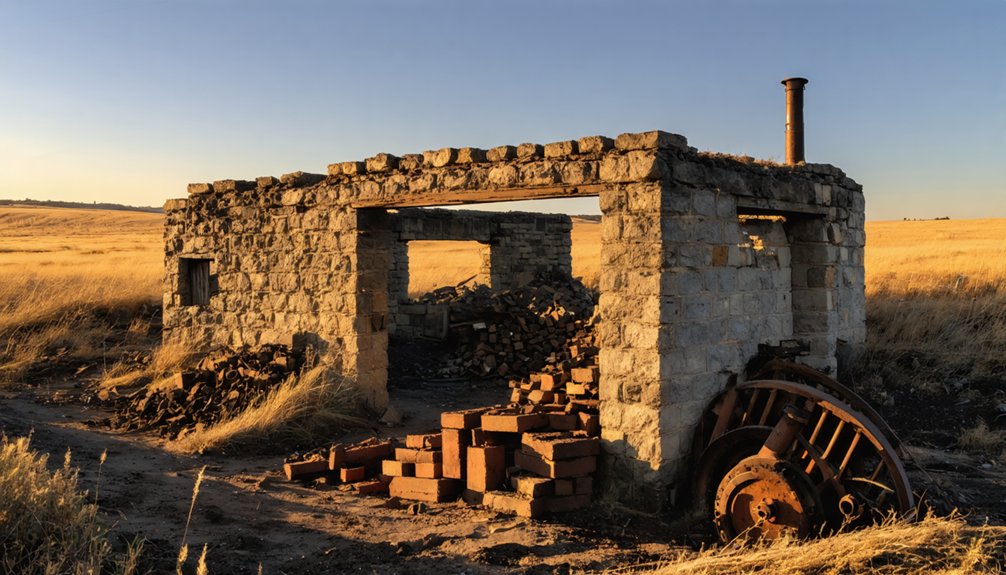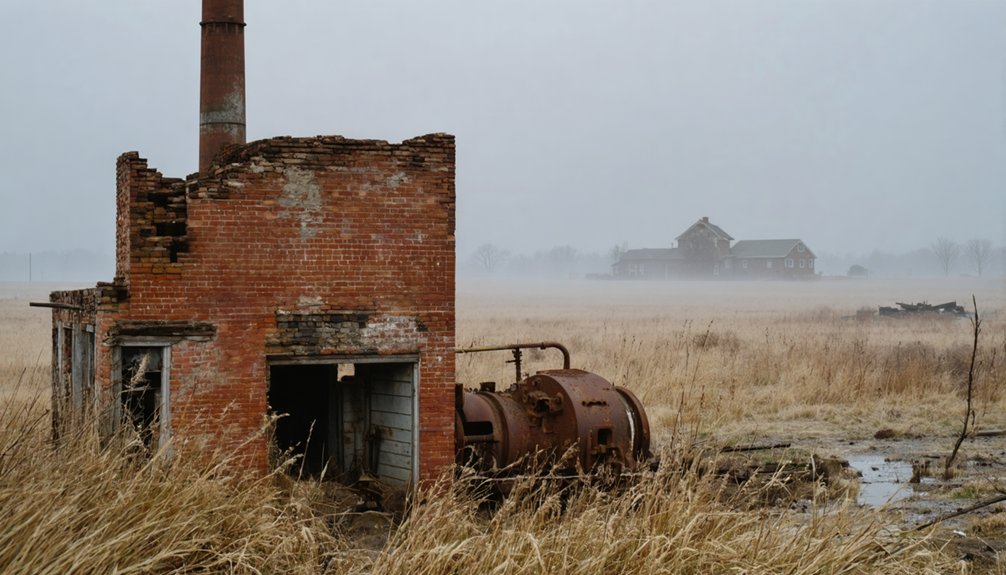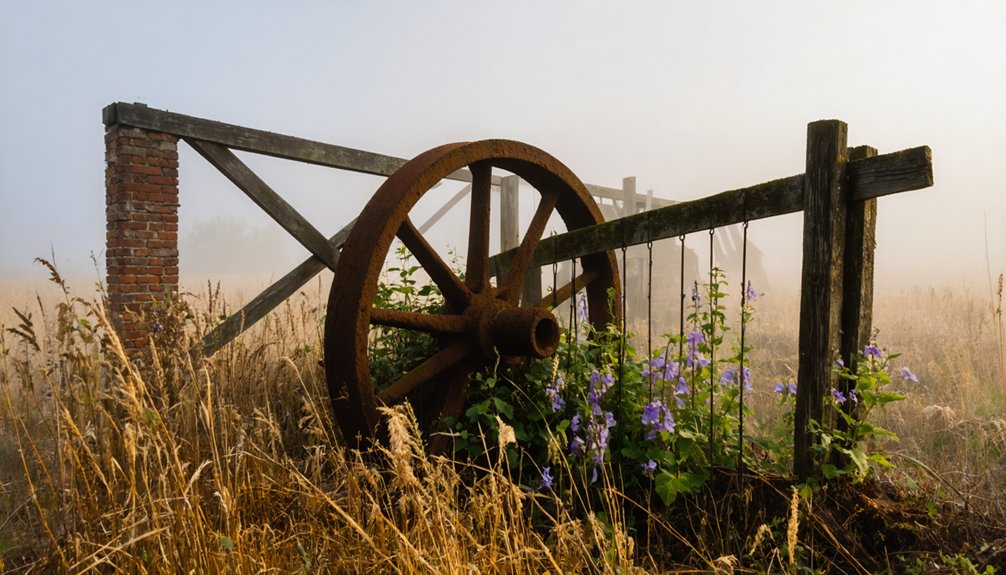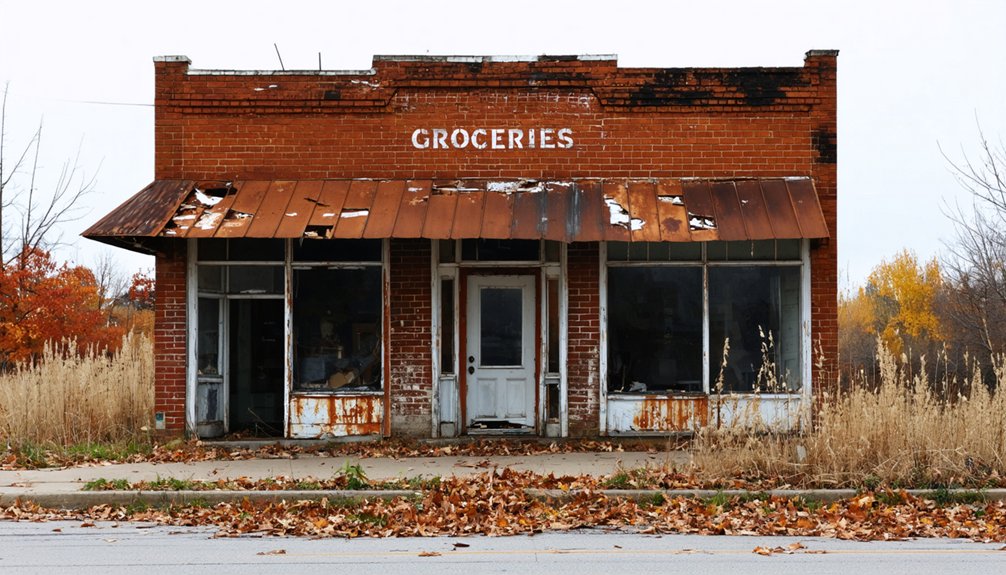Today you’ll find overgrown fields where Buxton, Iowa once thrived as America’s most progressive coal mining town from 1873 to the 1920s. You can explore the remnants of this remarkable 5,000-person community where Black and white miners earned equal wages, lived in integrated neighborhoods, and shared fully desegregated schools and businesses. The site’s listing on the National Register of Historic Places in 1983 preserves the story of this unique racial utopia that flourished in rural Iowa.
Key Takeaways
- Once Iowa’s largest coal mining town and most prosperous Black community, Buxton is now completely abandoned and converted to farmland.
- The town’s population peaked between 5,000-9,000 residents before declining in the 1920s due to decreased coal demand.
- All 2,000 original company houses and community buildings were eventually demolished, leaving minimal physical traces today.
- The site was listed on the National Register of Historic Places in 1983 to protect its historical significance.
- Former townsite land has been transformed into forests and farms, though preservation efforts continue through oral histories and documentation.
The Birth of a Progressive Mining Town
While many coal towns emerged across America during the late 1800s, Buxton’s founding in 1873 by the Consolidation Coal Company marked a distinctive chapter in Iowa’s mining history.
As railroad expansion pushed into Monroe County, CCC agent J.E. Buxton established operations that would later flourish under his son Ben’s leadership in 1895. The company’s commitment to growth was evident as they constructed two thousand homes for their workforce. The town quickly grew to become the largest coal town west of the Mississippi River in the early 1900s.
This progressive stance on labor activism meant all miners, regardless of race, worked under union contracts with steady employment and competitive wages, while the railroad’s guaranteed coal purchases guaranteed the town’s economic stability.
You’ll find that Buxton’s approach to community resilience set it apart. Rather than following the typical discriminatory practices of the era, the company actively recruited Black workers from the South through agents like H.A. Armstrong, offering them skilled positions and equal treatment.
A Diverse Community Ahead of Its Time
In defiance of America’s segregated norms, you’d find Black and white residents of Buxton living, working, and learning side by side in the early 1900s.
You could witness Black doctors treating patients of all races, while Black and white miners earned equal wages working the same jobs in the unionized mines.
This remarkable social experiment flourished as interracial marriages were accepted, and Black entrepreneurs operated successful businesses alongside their white counterparts in a town that peaked at 5,000-9,000 residents.
The town offered its integrated community high-quality homes and exceptional amenities including a three-story YMCA.
Every summer, both races would come together to celebrate Emancipation Day with company-supported festivities.
Racial Harmony Prevails
During an era when racial segregation dominated American society, Buxton, Iowa stood as a remarkable exception, fostering genuine integration across residential, economic, and social spheres.
You’d find integrated neighborhoods where Black and white families lived side by side, with housing assignments based purely on arrival order rather than race. This community cohesion extended throughout daily life, creating an environment where racial harmony wasn’t just an ideal – it was reality. The three bedroom houses provided by the coal company offered spacious living quarters to all miners. The town’s success in racial integration made it a significant hub during The Great Migration.
- Black-owned businesses thrived alongside white establishments, while doctors served patients of all races.
- Schools, churches, and social organizations welcomed everyone, regardless of racial background.
- Equal pay and fair treatment prevailed at Consolidation Coal Company, where Black and white miners worked together in unified unions.
Equal Pay Revolution
At a time when racial wage discrimination prevailed across America, Buxton’s equal pay policies stood as a revolutionary model of workplace fairness.
You’d find Black and white miners working side by side in the coal mines, earning equal wages for the same work – a practice virtually unheard of in early 1900s America.
The Coal Consolidation Company’s commitment to racial equity wasn’t just moral; it was smart business. They knew fair pay would attract skilled workers, regardless of race.
This strategy worked brilliantly, drawing African Americans from the South and European immigrants seeking better opportunities.
The forty resident-owned businesses in town demonstrated the thriving entrepreneurial spirit that equal economic opportunity created.
The company’s progressive policies extended beyond wages to include equal access to housing and business loans, creating unprecedented economic mobility for Black families.
It’s no wonder Buxton became a beacon of hope, with African Americans comprising 55% of its workforce.
The town’s remarkable peaceful racial coexistence lasted approximately 25 years until its abandonment in 1925.
Economic Prosperity Through Coal
You’ll find the roots of Buxton’s economic success in its partnership with the Chicago and Northwestern Railway Company, which guaranteed steady coal purchases and provided reliable employment for the town’s miners.
The railroad’s commitment to the region led them to extend their line into Monroe County and actively recruit African American workers from the South, offering equal pay regardless of race. Miners could easily bookmark results of their work records and pay stubs for future reference.
This steady stream of work and fair compensation created unprecedented economic opportunities in Buxton, making it one of the largest and most prosperous coal mining towns west of the Mississippi River. The town’s population grew rapidly to become the largest unincorporated city in the nation with around 5,000 residents.
Railroad Fuels Mining Growth
Because the Chicago and Northwestern Railway owned both the Consolidation Coal Company and the town of Buxton, the community’s economic prosperity was uniquely assured through guaranteed coal contracts.
You’ll find that railroad expansion directly fueled Buxton’s growth, as the C&NW Railway needed a steady coal supply for its expanding operations. The company controlled every aspect of the mining town’s development, from housing to infrastructure.
- By 1906, local mines produced over 1.1 million tons of coal, making Monroe County a leading Iowa producer
- Mining technology and operations grew to support the largest coal town west of the Mississippi
- The railroad’s “captive mine” system guaranteed steady work and higher wages compared to other mining communities
This unique arrangement lasted until the 1920s, when declining coal demand and exhausted deposits led to Buxton’s eventual abandonment.
Equal Pay, Equal Work
The economic prosperity of Buxton stood apart from other mining towns through its groundbreaking approach to worker equality. You’d find African Americans making up to 90% of the workforce, earning the same wages as their white counterparts – a rarity in early 1900s America. This economic empowerment created unprecedented opportunities, with Black professionals establishing successful careers as doctors, lawyers, and business owners.
The Consolidation Coal Company’s commitment to equal pay fostered remarkable community engagement. You could see this reflected in the thriving YMCA, churches, and social clubs that brought together miners of all backgrounds.
The company’s firm stance against discrimination, combined with guaranteed coal contracts from the railroad, guaranteed stable employment and consistent income for all workers, transforming Buxton into the largest coal town west of the Mississippi.
Daily Life in an Integrated Society
Life in Buxton defied typical racial dynamics of early 1900s America, as Black and white residents shared neighborhoods, workplaces, and social spaces without formal segregation.
You’d find integrated neighborhoods where families lived side-by-side in identical 1½-story company houses, creating a uniquely egalitarian atmosphere for the era.
Daily life revolved around:
Community life was the heartbeat of Buxton, where everyday activities brought people together across racial boundaries.
- Community activities like baseball games and YMCA gatherings where all races participated freely
- Shopping at the company store, where both Black and white clerks served customers without discrimination
- Attending one of the town’s many churches or sending children to integrated schools
The company town model fostered natural integration, with social divisions existing more between management and workers than along racial lines, creating a remarkable example of racial cooperation in early 20th century America.
Cultural and Social Achievements

You’d find a remarkable level of racial harmony in Buxton, where Black and white residents freely lived, worked, and socialized together without the barriers common during the Jim Crow era.
The town’s integration extended beyond mere coexistence, as evidenced by accepted interracial marriages and the fully integrated school system where children of all backgrounds learned side by side.
The community’s pride manifested through shared cultural institutions like the Buxton Wonders baseball team and the African-American YMCA, which served as gathering places for all residents regardless of race.
Interracial Harmony and Integration
During an era when racial segregation dominated American society, Buxton, Iowa stood as a remarkable exception, fostering genuine integration across all aspects of community life. In this unique mining town, you’d find a level of racial harmony that was unheard of elsewhere in early 20th century America.
- Schools operated on a fully integrated basis, with children of all races learning side-by-side, creating bonds that transcended racial boundaries.
- Community events brought together African Americans, European immigrants, and other ethnic groups in shared celebrations and gatherings.
- Housing assignments were based purely on availability rather than race, resulting in naturally integrated neighborhoods where families of different backgrounds lived as neighbors.
This progressive approach to integration created a thriving community where interracial marriages were accepted and diverse cultural traditions flourished together.
Community Pride and Achievement
Despite lacking formal municipal governance, Buxton developed into a culturally rich and socially advanced community that defied the era’s racial and economic constraints.
You’ll find that community resilience manifested through vibrant social clubs, cultural events, and shared values that united residents across racial lines. Churches served as pillars of daily life, with Buxton boasting more houses of worship per capita than comparable towns.
The town’s commitment to excellence showed in well-maintained homes, thriving businesses, and integrated schools that achieved remarkable literacy rates. Black entrepreneurs owned various establishments, from grocery stores to barbershops, while professionals like doctors and teachers further elevated the community’s status.
This spirit of achievement earned Buxton recognition on the National Register of Historic Places in 1983.
The Rise and Fall of Mining Operations
When the Consolidation Coal Company established mining operations in Southeast Iowa during the 1870s, they sparked what would become one of the region’s most significant coal-producing centers.
As mining technology advanced and economic shifts transformed the region, you’d find Buxton emerging as a powerhouse of coal production, particularly during its peak in the early 1900s.
- The mines supplied coal exclusively to the Chicago & Northwestern Railroad, ensuring steady employment and demand.
- African-American miners earned equal wages alongside white workers, producing up to 200,000 tons of coal annually.
- Multiple mining companies, including Ackers Coal and Regal Coal, expanded operations in the area.
The prosperity wouldn’t last forever.
After World War I, the changeover to diesel engines and mine mechanization led to decreased demand, while devastating fires damaged critical infrastructure, ultimately leading to Buxton’s decline.
Notable People and Places

Among the notable figures who shaped Buxton’s remarkable history, Benjamin Buxton stands out as the town’s visionary founder and planner. At just 25, he became superintendent of the Consolidation Coal Company, following in the footsteps of J.E. Buxton, who’d laid the groundwork as the company’s agent.
You’ll find their influence throughout the town’s distinctive landmarks, from Center Street’s Coal Chute Hill to the culturally diverse neighborhoods of East and West Swede Town. The Buxton founders created a uniquely integrated community where notable figures like Madame C.J. Walker visited, and memoirist Reuben Gaines documented daily life.
While areas like Goopertown gained notoriety for vice, Buxton’s most significant landmarks were its integrated schools and businesses, reflecting the town’s commitment to racial equality.
Preserving Buxton’s History
Since Buxton’s decline in the early 1900s, preservation efforts have focused on protecting both the physical remnants and cultural legacy of this remarkable integrated coal mining town.
Preservationists work to safeguard both tangible remains and historical memory of Buxton, Iowa’s pioneering integrated mining community.
Through community engagement and historical narratives, you’ll find multiple preservation initiatives keeping Buxton’s memory alive:
- The National Register of Historic Places listed the townsite in 1983, protecting archaeological remnants and two surviving buildings.
- Iowa Public TV documentaries and oral histories from descendants maintain the town’s cultural significance.
- Educational programs incorporate Buxton’s story into school curricula, highlighting themes of racial integration and labor history.
While physical preservation faces challenges due to farmland conversion and minimal infrastructure, you can still experience Buxton’s legacy through documentaries, exhibits, and community gatherings that celebrate this unique chapter in Iowa’s history.
Life After the Mining Era

As the coal industry declined in the early 1900s, Buxton’s once-thriving population plummeted to just 400 residents by 1919. The shift from coal to electric locomotives dealt a crushing blow, forcing Consolidation Coal Co. to relocate its headquarters to Haydock in 1923.
Post mining challenges hit former residents hard as they faced harsh realities in new communities. You’d find many struggling to adapt to places where racial segregation was the norm, a stark contrast to Buxton’s integrated society.
The community relocation scattered families across different regions, searching for work opportunities that couldn’t match their former lives. The town’s buildings were eventually torn down, and the land transformed into forests and farms, leaving only memories of a unique experiment in racial equality in early 20th century Iowa.
The Legacy of a Racial Utopia
The remarkable social experiment that was Buxton left an indelible mark on American history.
You’ll find few other examples of such progressive racial dynamics in early 20th century America, where African Americans and whites lived, worked, and thrived together as equals.
The community’s resilience stemmed from its unprecedented integration across all aspects of life.
- Black professionals, including doctors and lawyers, served clients of all races while achieving national prominence.
- The town fostered true integration in schools, businesses, and social spaces – a revolutionary concept during the Jim Crow era.
- Mutual aid societies and unions united residents across racial lines, creating a support system that protected everyone’s interests.
Today, Buxton’s legacy reminds you that racial harmony wasn’t just possible – it was once achieved in the American heartland.
Frequently Asked Questions
What Was the Average Wage of Miners in Buxton Compared to Other Towns?
You’d find wage disparities favoring Buxton’s miners, who earned $50-$100 weekly in gold and silver, surpassing other mining towns’ pay rates thanks to their stable, unionized mining economy.
How Did the Local Law Enforcement Handle Disputes Between Different Ethnic Groups?
Like a peaceful oasis, you’d find virtually no ethnic tensions requiring law enforcement intervention. The company’s management handled conflict resolution effectively, preventing disputes from escalating between different racial groups in the community.
What Happened to the Company’s Mining Equipment After Buxton Was Abandoned?
You’d find little historical preservation of the equipment today – most was either dismantled, sold off, or scrapped by Consolidation Coal Company during the 1927 closure, with no organized equipment repurposing efforts.
Were There Any Major Epidemics or Health Crises in Buxton?
Despite having a Google-like health infrastructure with Black doctors and pharmacists, you won’t find records of any major epidemic impact in the town’s history beyond typical coal mining-related respiratory issues.
Did Any Significant Inventions or Technological Innovations Emerge From Buxton’s Mining Operations?
While you won’t find groundbreaking mining technology from Buxton’s operations, its community innovations in labor management and racial integration created unique operational efficiencies that influenced coal mining productivity throughout Iowa.
References
- https://pubs.lib.uiowa.edu/annals-of-iowa/article/10852/galley/119423/view/
- https://iowa.minisisinc.com/scripts/mwimain.dll/144/PRIMARY_SOURCES/WEB_PS_DET?COMMANDSEARCH&NOMSG=[IOWA_ROOT]no-record-primary-sources.html&EXP=PS_SOURCE_TITLE%20″Buxton:+A+Lost+Utopia”
- https://teachingiowahistory.org/lesson-plans/buxton-iowa-former-black-utopia
- https://iowastartingline.com/2022/02/27/buxton-iowas-lost-black-utopia/
- https://www.youtube.com/watch?v=ka8Ys_htFr8
- https://en.wikipedia.org/wiki/Buxton_Historic_Townsite
- https://reformedjournal.com/2019/07/05/ghost-town-legacy/
- http://www.iowapbs.org/iowapathways/mypath/2531/great-buxton
- https://aaregistry.org/story/buxton-iowa-founded/
- https://reason.com/2024/02/08/the-life-and-death-of-a-company-town/



